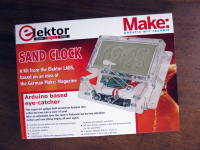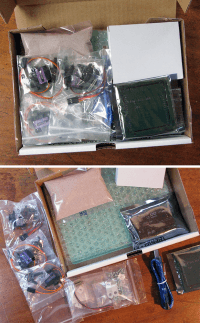Review: Elektor/Make: Sand Clock Kit
February 16, 2017
on
on
 Described in the January & February 2017 edition of Elektor, the Sand Clock project, unique for its mechanical design, is all the better for its availability in kit form, which I’ve wanted to examine more closely in order to review it here. You’d have to be very jaded not to be seduced by the amusing principle of this gadget: to write the time in sand every minute, with a stylus on a pantograph and some servomotors, and erase it just before the next minute, and repeat endlessly. It is both clever and poetic.
Described in the January & February 2017 edition of Elektor, the Sand Clock project, unique for its mechanical design, is all the better for its availability in kit form, which I’ve wanted to examine more closely in order to review it here. You’d have to be very jaded not to be seduced by the amusing principle of this gadget: to write the time in sand every minute, with a stylus on a pantograph and some servomotors, and erase it just before the next minute, and repeat endlessly. It is both clever and poetic. The attraction of such a project with its strong mechanical content rests in the various constraints (precision, simplicity, reproducibility, elegance etc.); the designer of the kit has resolved these problems very well. For the beginner maker, the construction of this kit and the study of the solution adopted will be very enlightening.
The attraction of such a project with its strong mechanical content rests in the various constraints (precision, simplicity, reproducibility, elegance etc.); the designer of the kit has resolved these problems very well. For the beginner maker, the construction of this kit and the study of the solution adopted will be very enlightening.This seems to me a great way to occupy a rainy February afternoon!
Unpacking
The kit is presented in a box of which the size and weight are mainly due to the mechanical components, carefully packed with the PMMA (usually called Plexiglass™ or Perspex™) panels for the chassis, mini servomotors, mini vibrating motors, an assortment of bolts, nuts, washers, pins, spacers, adhesive pads and finally a packet of fine sand. On the electronics side, there is an Arduino R3 board, an Elektor shield partially assembled (SMDs mounted), a real time clock (RTC) and connectors for the servos, a USB cable, a 230 V – 9 V power supply and a button cell battery.Perfect presentation, but is there anything missing?
Read full article
Hide full article


Discussion (17 comments)